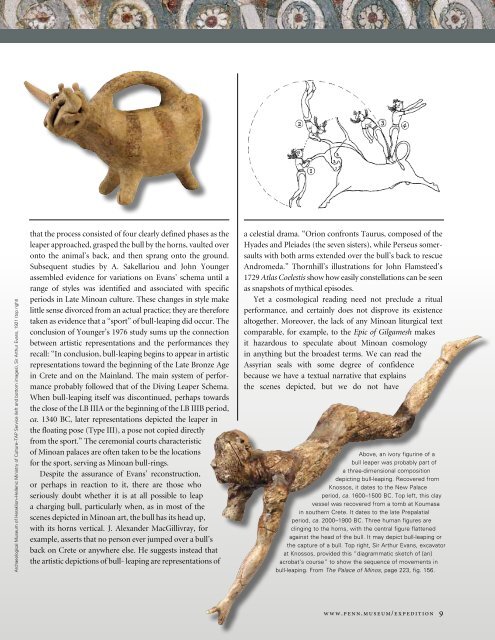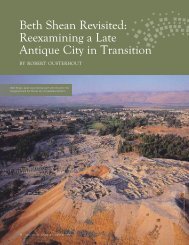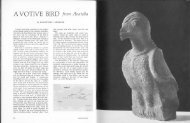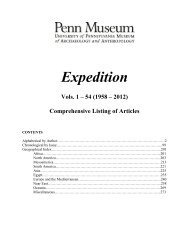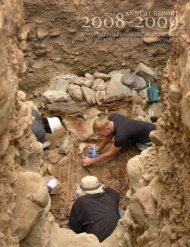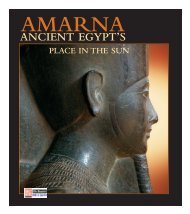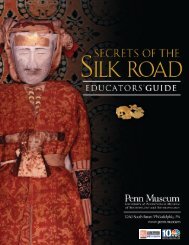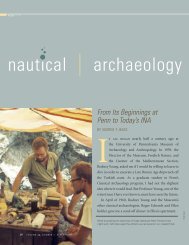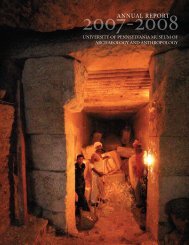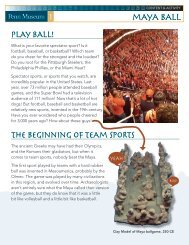Bulls and Bull-leaping in the Minoan World - University of ...
Bulls and Bull-leaping in the Minoan World - University of ...
Bulls and Bull-leaping in the Minoan World - University of ...
Create successful ePaper yourself
Turn your PDF publications into a flip-book with our unique Google optimized e-Paper software.
Archaeological Museum <strong>of</strong> Heraklion–Hellenic M<strong>in</strong>istry <strong>of</strong> Culture–TAP Service (left <strong>and</strong> bottom images), Sir Arthur Evans, 1921 (top right)<br />
that <strong>the</strong> process consisted <strong>of</strong> four clearly def<strong>in</strong>ed phases as <strong>the</strong><br />
leaper approached, grasped <strong>the</strong> bull by <strong>the</strong> horns, vaulted over<br />
onto <strong>the</strong> animal’s back, <strong>and</strong> <strong>the</strong>n sprang onto <strong>the</strong> ground.<br />
Subsequent studies by A. Sakellariou <strong>and</strong> John Younger<br />
assembled evidence for variations on Evans’ schema until a<br />
range <strong>of</strong> styles was identified <strong>and</strong> associated with specific<br />
periods <strong>in</strong> Late M<strong>in</strong>oan culture. These changes <strong>in</strong> style make<br />
little sense divorced from an actual practice; <strong>the</strong>y are <strong>the</strong>refore<br />
taken as evidence that a “sport” <strong>of</strong> bull-<strong>leap<strong>in</strong>g</strong> did occur. The<br />
conclusion <strong>of</strong> Younger’s 1976 study sums up <strong>the</strong> connection<br />
between artistic representations <strong>and</strong> <strong>the</strong> performances <strong>the</strong>y<br />
recall: “In conclusion, bull-<strong>leap<strong>in</strong>g</strong> beg<strong>in</strong>s to appear <strong>in</strong> artistic<br />
representations toward <strong>the</strong> beg<strong>in</strong>n<strong>in</strong>g <strong>of</strong> <strong>the</strong> Late Bronze Age<br />
<strong>in</strong> Crete <strong>and</strong> on <strong>the</strong> Ma<strong>in</strong>l<strong>and</strong>. The ma<strong>in</strong> system <strong>of</strong> performance<br />
probably followed that <strong>of</strong> <strong>the</strong> Div<strong>in</strong>g Leaper Schema.<br />
When bull-<strong>leap<strong>in</strong>g</strong> itself was discont<strong>in</strong>ued, perhaps towards<br />
<strong>the</strong> close <strong>of</strong> <strong>the</strong> LB IIIA or <strong>the</strong> beg<strong>in</strong>n<strong>in</strong>g <strong>of</strong> <strong>the</strong> LB IIIB period,<br />
ca. 1340 BC, later representations depicted <strong>the</strong> leaper <strong>in</strong><br />
<strong>the</strong> float<strong>in</strong>g pose (Type III), a pose not copied directly<br />
from <strong>the</strong> sport.” The ceremonial courts characteristic<br />
<strong>of</strong> M<strong>in</strong>oan palaces are <strong>of</strong>ten taken to be <strong>the</strong> locations<br />
for <strong>the</strong> sport, serv<strong>in</strong>g as M<strong>in</strong>oan bull-r<strong>in</strong>gs.<br />
Despite <strong>the</strong> assurance <strong>of</strong> Evans’ reconstruction,<br />
or perhaps <strong>in</strong> reaction to it, <strong>the</strong>re are those who<br />
seriously doubt whe<strong>the</strong>r it is at all possible to leap<br />
a charg<strong>in</strong>g bull, particularly when, as <strong>in</strong> most <strong>of</strong> <strong>the</strong><br />
scenes depicted <strong>in</strong> M<strong>in</strong>oan art, <strong>the</strong> bull has its head up,<br />
with its horns vertical. J. Alex<strong>and</strong>er MacGillivray, for<br />
example, asserts that no person ever jumped over a bull’s<br />
back on Crete or anywhere else. He suggests <strong>in</strong>stead that<br />
<strong>the</strong> artistic depictions <strong>of</strong> bull- <strong>leap<strong>in</strong>g</strong> are representations <strong>of</strong><br />
a celestial drama. “Orion confronts Taurus, composed <strong>of</strong> <strong>the</strong><br />
Hyades <strong>and</strong> Pleiades (<strong>the</strong> seven sisters), while Perseus somersaults<br />
with both arms extended over <strong>the</strong> bull’s back to rescue<br />
Andromeda.” Thornhill’s illustrations for John Flamsteed’s<br />
1729 Atlas Coelestis show how easily constellations can be seen<br />
as snapshots <strong>of</strong> mythical episodes.<br />
Yet a cosmological read<strong>in</strong>g need not preclude a ritual<br />
performance, <strong>and</strong> certa<strong>in</strong>ly does not disprove its existence<br />
altoge<strong>the</strong>r. Moreover, <strong>the</strong> lack <strong>of</strong> any M<strong>in</strong>oan liturgical text<br />
comparable, for example, to <strong>the</strong> Epic <strong>of</strong> Gilgamesh makes<br />
it hazardous to speculate about M<strong>in</strong>oan cosmology<br />
<strong>in</strong> anyth<strong>in</strong>g but <strong>the</strong> broadest terms. We can read <strong>the</strong><br />
Assyrian seals with some degree <strong>of</strong> confidence<br />
because we have a textual narrative that expla<strong>in</strong>s<br />
<strong>the</strong> scenes depicted, but we do not have<br />
Above, an ivory figur<strong>in</strong>e <strong>of</strong> a<br />
bull leaper was probably part <strong>of</strong><br />
a three-dimensional composition<br />
depict<strong>in</strong>g bull-<strong>leap<strong>in</strong>g</strong>. Recovered from<br />
Knossos, it dates to <strong>the</strong> New Palace<br />
period, ca. 1600–1500 BC. Top left, this clay<br />
vessel was recovered from a tomb at Koumasa<br />
<strong>in</strong> sou<strong>the</strong>rn Crete. It dates to <strong>the</strong> late Prepalatial<br />
period, ca. 2000–1900 BC. Three human figures are<br />
cl<strong>in</strong>g<strong>in</strong>g to <strong>the</strong> horns, with <strong>the</strong> central figure flattened<br />
aga<strong>in</strong>st <strong>the</strong> head <strong>of</strong> <strong>the</strong> bull. It may depict bull-<strong>leap<strong>in</strong>g</strong> or<br />
<strong>the</strong> capture <strong>of</strong> a bull. Top right, Sir Arthur Evans, excavator<br />
at Knossos, provided this “diagrammatic sketch <strong>of</strong> [an]<br />
acrobat’s course” to show <strong>the</strong> sequence <strong>of</strong> movements <strong>in</strong><br />
bull-<strong>leap<strong>in</strong>g</strong>. From The Palace <strong>of</strong> M<strong>in</strong>os, page 223, fig. 156.<br />
www.penn.museum/expedition 9


